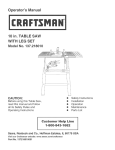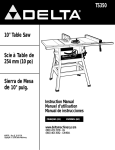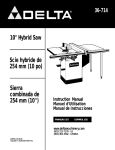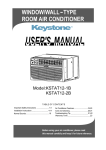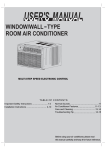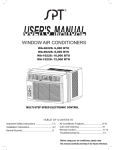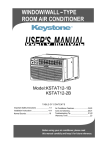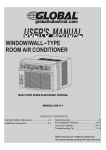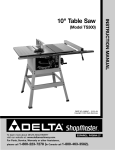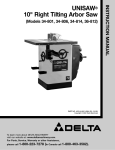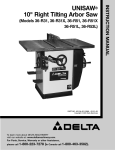Download Delt TS350 Instruction manual
Transcript
(Model TS350) PART NO. A05728 - 08-26-05 - Rev. A Copyright © 2005 Delta Machinery To learn more about DELTA MACHINERY visit our website at: www.deltamachinery.com. For Parts, Service, Warranty or other Assistance, ESPAÑOL: PÁGINA 29 please call 1-800-223-7278 (In Canada call 1-800-463-3582). INSTRUCTION MANUAL 10" Table Saw TABLE OF CONTENTS IMPORTANT SAFETY INSTRUCTIONS . . . . . . . . . . . . . . . . . . . . . . . . . . . . . . . . . . . . . . . . . . . . . . . . . . . . . . . . . . . . 2 SAFETY GUIDELINES - DEFINITIONS. . . . . . . . . . . . . . . . . . . . . . . . . . . . . . . . . . . . . . . . . . . . . . . . . . . . . . . . . . . . . 3 GENERAL SAFETY RULES . . . . . . . . . . . . . . . . . . . . . . . . . . . . . . . . . . . . . . . . . . . . . . . . . . . . . . . . . . . . . . . . . . . . . 4 ADDITIONAL SPECIFIC SAFETY RULES. . . . . . . . . . . . . . . . . . . . . . . . . . . . . . . . . . . . . . . . . . . . . . . . . . . . . . . . . . . 5 FUNCTIONAL DESCRIPTION . . . . . . . . . . . . . . . . . . . . . . . . . . . . . . . . . . . . . . . . . . . . . . . . . . . . . . . . . . . . . . . . . . . 7 CARTON CONTENTS . . . . . . . . . . . . . . . . . . . . . . . . . . . . . . . . . . . . . . . . . . . . . . . . . . . . . . . . . . . . . . . . . . . . . . . . . 8 ASSEMBLY. . . . . . . . . . . . . . . . . . . . . . . . . . . . . . . . . . . . . . . . . . . . . . . . . . . . . . . . . . . . . . . . . . . . . . . . . . . . . . . . . 10 OPERATION . . . . . . . . . . . . . . . . . . . . . . . . . . . . . . . . . . . . . . . . . . . . . . . . . . . . . . . . . . . . . . . . . . . . . . . . . . . . . . . . 18 TROUBLESHOOTING . . . . . . . . . . . . . . . . . . . . . . . . . . . . . . . . . . . . . . . . . . . . . . . . . . . . . . . . . . . . . . . . . . . . . . . . 26 MAINTENANCE . . . . . . . . . . . . . . . . . . . . . . . . . . . . . . . . . . . . . . . . . . . . . . . . . . . . . . . . . . . . . . . . . . . . . . . . . . . . . 26 SERVICE. . . . . . . . . . . . . . . . . . . . . . . . . . . . . . . . . . . . . . . . . . . . . . . . . . . . . . . . . . . . . . . . . . . . . . . . . . . . . . . . . . . 26 ACCESSORIES . . . . . . . . . . . . . . . . . . . . . . . . . . . . . . . . . . . . . . . . . . . . . . . . . . . . . . . . . . . . . . . . . . . . . . . . . . . . . 27 WARRANTY . . . . . . . . . . . . . . . . . . . . . . . . . . . . . . . . . . . . . . . . . . . . . . . . . . . . . . . . . . . . . . . . . . . . . . . . . . . . . . . . 28 ESPAÑOL . . . . . . . . . . . . . . . . . . . . . . . . . . . . . . . . . . . . . . . . . . . . . . . . . . . . . . . . . . . . . . . . . . . . . . . . . . . . . . . . . . 29 IMPORTANT SAFETY INSTRUCTIONS Read and understand all warnings and operating instructions before using any tool or equipment. When using tools or equipment, basic safety precautions should always be followed to reduce the risk of personal injury. Improper operation, maintenance or modification of tools or equipment could result in serious injury and property damage. There are certain applications for which tools and equipment are designed. Delta Machinery strongly recommends that this product NOT be modified and/or used for any application other than for which it was designed. If you have any questions relative to its application DO NOT use the product until you have written Delta Machinery and we have advised you. Online contact form at www.deltamachinery.com Postal Mail: Technical Service Manager Delta Machinery 4825 Highway 45 North Jackson, TN 38305 (IN CANADA: 125 Mural St. Suite 300, Richmond Hill, ON, L4B 1M4) Information regarding the safe and proper operation of this tool is available from the following sources: Power Tool Institute 1300 Sumner Avenue, Cleveland, OH 44115-2851 www.powertoolinstitute.org National Safety Council 1121 Spring Lake Drive, Itasca, IL 60143-3201 American National Standards Institute, 25 West 43rd Street, 4 floor, New York, NY 10036 www.ansi.org ANSI 01.1Safety Requirements for Woodworking Machines, and the U.S. Department of Labor regulations www.osha.gov SAVE THESE INSTRUCTIONS! 2 SAFETY GUIDELINES - DEFINITIONS It is important for you to read and understand this manual. The information it contains relates to protecting YOUR SAFETY and PREVENTING PROBLEMS. The symbols below are used to help you recognize this information. Indicates an imminently hazardous situation which, if not avoided, will result in death or serious injury. Indicates a potentially hazardous situation which, if not avoided, could result in death or serious injury. Indicates a potentially hazardous situation which, if not avoided, may result in minor or moderate injury. Used without the safety alert symbol indicates potentially hazardous situation which, if not avoided, may result in property damage. CALIFORNIA PROPOSITION 65 Some dust created by power sanding, sawing, grinding, drilling, and other construction activities contains chemicals known to cause cancer, birth defects or other reproductive harm. Some examples of these chemicals are: • lead from lead-based paints, • crystalline silica from bricks and cement and other masonry products, and • arsenic and chromium from chemically-treated lumber. Your risk from these exposures varies, depending on how often you do this type of work. To reduce your exposure to these chemicals: work in a well ventilated area, and work with approved safety equipment, always wear NIOSH/OSHA approved, properly fitting face mask or respirator when using such tools. 3 GENERAL SAFETY RULES READ AND UNDERSTAND ALL WARNINGS AND OPERATING INSTRUCTIONS BEFORE USING THIS EQUIPMENT. Failure to follow all instructions listed below, may result in electric shock, fire, and/or serious personal injury or property damage. IMPORTANT SAFETY INSTRUCTIONS 1. FOR YOUR OWN SAFETY, READ THE INSTRUCTION MANUAL BEFORE OPERATING THE MACHINE. Learning the machine’s application, limitations, and specific hazards will greatly minimize the possibility of accidents and injury. 2. WEAR EYE AND HEARING PROTECTION. ALWAYS USE SAFETY GLASSES. Everyday eyeglasses are NOT safety glasses. USE CERTIFIED SAFETY EQUIPMENT. Eye protection equipment should comply with ANSI Z87.1 standards. Hearing equipment should comply with ANSI S3.19 standards. 3. 4. 5. 6. 15. SECURE THE WORKPIECE. Use clamps or vise when you cannot secure the workpiece on the table and against the fence by hand or when your hand will be dangerously close to the blade (within 6”). WEAR PROPER APPAREL. Do not wear loose clothing, gloves, neckties, rings, bracelets, or other jewelry which may get caught in moving parts. Nonslip footwear is recommended. Wear protective hair covering to contain long hair. 16. FEED THE WORKPIECE AGAINST THE DIRECTION OF THE ROTATION OF THE BLADE, CUTTER, OR ABRASIVE SURFACE. Feeding it from the other direction will cause the workpiece to be thrown out at high speed. DO NOT USE THE MACHINE IN A DANGEROUS ENVIRONMENT. The use of power tools in damp or wet locations or in rain can cause shock or electrocution. Keep your work area well-lit to prevent tripping or placing arms, hands, and fingers in danger. 17. DON’T FORCE THE WORKPIECE ON THE MACHINE. Damage to the machine and/or injury may result. 18. DON’T OVERREACH. Loss of balance can make you fall into a working machine, causing injury. MAINTAIN ALL TOOLS AND MACHINES IN PEAK CONDITION. Keep tools sharp and clean for best and safest performance. Follow instructions for lubricating and changing accessories. Poorly maintained tools and machines can further damage the tool or machine and/or cause injury. 19. NEVER STAND ON THE MACHINE. Injury could occur if the tool tips, or if you accidentally contact the cutting tool. 20. NEVER LEAVE THE MACHINE RUNNING UNATTENDED. TURN THE POWER OFF. Don’t leave the machine until it comes to a complete stop. A child or visitor could be injured. CHECK FOR DAMAGED PARTS. Before using the machine, check for any damaged parts. Check for alignment of moving parts, binding of moving parts, breakage of parts, and any other conditions that may affect its operation. A guard or any other part that is damaged should be properly repaired or replaced. Damaged parts can cause further damage to the machine and/or injury. 7. KEEP THE WORK AREA CLEAN. Cluttered areas and benches invite accidents. 8. KEEP CHILDREN AND VISITORS AWAY. Your shop is a potentially dangerous environment. Children and visitors can be injured. 9. 14. USE THE PROPER EXTENSION CORD. Make sure your extension cord is in good condition. When using an extension cord, be sure to use one heavy enough to carry the current your product will draw. An undersized cord will cause a drop in line voltage, resulting in loss of power and overheating. See the Extension Cord Chart for the correct size depending on the cord length and nameplate ampere rating. If in doubt, use the next heavier gauge. The smaller the gauge number, the heavier the cord. 21. TURN THE MACHINE “OFF”, AND DISCONNECT THE MACHINE FROM THE POWER SOURCE before installing or removing accessories, before adjusting or changing set-ups, or when making repairs. An accidental start-up can cause injury. 22. MAKE YOUR WORKSHOP CHILDPROOF WITH PA D L O C K S , M A S T E R S W I T C H E S , O R B Y REMOVING STARTER KEYS. The accidental start-up of a machine by a child or visitor could cause injury. 23. STAY ALERT, WATCH WHAT YOU ARE DOING, AND USE COMMON SENSE. DO NOT USE THE MACHINE WHEN YOU ARE TIRED OR UNDER THE INFLUENCE OF DRUGS, ALCOHOL, OR MEDICATION. A moment of INATTENTION WHILE OPERATING POWER TOOLS MAY RESULT IN INJURY. REDUCE THE RISK OF UNINTENTIONAL STARTING. Make sure that the switch is in the “OFF” position before plugging in the power cord. In the event of a power failure, move the switch to the “OFF” position. An accidental start-up can cause injury. 24. 10. USE THE GUARDS. Check to see that all guards are in place, secured, and working correctly to reduce the risk of injury. 11. REMOVE ADJUSTING KEYS AND WRENCHES BEFORE STARTING THE MACHINE. Tools, scrap pieces, and other debris can be thrown at high speed, causing injury. 12. USE THE RIGHT MACHINE. Don’t force a machine or an attachment to do a job for which it was not designed. Damage to the machine and/or injury may result. 13. USE RECOMMENDED ACCESSORIES. The use of accessories and attachments not recommended by Delta may cause damage to the machine or injury to the user. 4 USE OF THIS TOOL CAN GENERATE AND DISBURSE DUST OR OTHER AIRBORNE PARTICLES, INCLUDING WOOD DUST, CRYSTALLINE SILICA DUST AND ASBESTOS DUST. Direct particles away from face and body. Always operate tool in well ventilated area and provide for proper dust removal. Use dust collection system wherever possible. Exposure to the dust may cause serious and permanent respiratory or other injury, including silicosis (a serious lung disease), cancer, and death. Avoid breathing the dust, and avoid prolonged contact with dust. Allowing dust to get into your mouth or eyes, or lay on your skin may promote absorption of harmful material. Always use properly fitting NIOSH/OSHA approved respiratory protection appropriate for the dust exposure, and wash exposed areas with soap and water. ADDITIONAL SPECIFIC SAFETY RULES FAILURE TO FOLLOW THESE RULES MAY RESULT IN SERIOUS PERSONAL INJURY. 1. DO NOT OPERATE THIS MACHINE until it is assembled and installed according to the instructions. 2. OBTAIN ADVICE FROM YOUR SUPERVISOR, instructor, or another qualified person if you are not familiar with the operation of this machine. 3. FOLLOW ALL WIRING CODES and recommended electrical connections. 4. USE THE GUARDS WHENEVER POSSIBLE. Check to see that they are in place, secured, and working correctly. 5. KICKBACK IS THE NATURAL TENDENCY OF THE WORKPIECE TO BE THROWN BACK AT THE OPERATOR when the workpiece initially contacts the blade or if the workpiece pinches the blade. Kickback is dangerous and can result in serious injury. 6. AVOID KICKBACK by: A. keeping blade sharp and free of rust and pitch. B. keeping rip fence parallel to the saw blade. C. using saw blade guard and spreader for every possible operation, including all through sawing. D. pushing the workpiece past the saw blade prior to release. E. never ripping a workpiece that is twisted or warped, or does not have a straight edge to guide along the fence. F. using featherboards when the anti-kickback device cannot be used. G. never sawing a large workpiece that cannot be controlled. H. never using the fence as a guide when crosscutting. I. never sawing a workpiece with loose knots or other flaws. ALWAYS USE GUARDS, SPLITTER, AND ANTIKICKBACK FINGERS whenever possible. 7. REMOVE CUT-OFF PIECES AND SCRAPS from the table before starting the saw. The vibration of the machine may cause them to move into the saw blade and be thrown out. After cutting, turn the machine off. After the blade has come to a complete stop, remove all debris. 8. NEVER START THE MACHINE with the workpiece against the blade. 9. NEVER run the workpiece between the fence and a moulding cutterhead. 10. CUTTING THE WORKPIECE WITHOUT THE USE OF A FENCE OR MITER GAUGE IS KNOWN AS “FREEHAND” CUTTING. NEVER perform “free-hand” operations. Use either the fence or miter gauge to position and guide the workpiece. 11. HOLD THE WORKPIECE FIRMLY against the miter gauge or fence. 12. CUTTING COMPLETELY THROUGH THE WORKPIECE IS KNOWN AS “THROUGH-SAWING”. Ripping and cross-cutting are through-sawing operations. Cutting with the grain (or down the length of the workpiece) is ripping. Cutting across the grain (or across the workpiece) is cross-cutting. Use a fence or fence system for ripping. DO NOT use a fence or fence system for cross-cutting. Instead, use a miter gauge. USE PUSH STICK(S) for ripping a narrow workpiece. 13. AVOID AWKWARD OPERATIONS AND HAND POSITIONS where a sudden slip could cause a hand to move into the blade. 14. KEEP ARMS, HANDS, AND FINGERS away from the blade. 15. NEVER have any part of your body in line with the path of the saw blade. 16. NEVER REACH AROUND or over the saw blade. 17. NEVER attempt to free a stalled saw blade without first turning the machine “OFF”. 18. PROPERLY SUPPORT LONG OR WIDE workpieces. 19. NEVER PERFORM LAYOUT, assembly or set-up work on the table/work area when the machine is running. 20. TURN THE MACHINE “OFF” AND DISCONNECT THE MACHINE from the power source before installing or removing accessories, before adjusting or changing set-ups, or when making repairs. 21. TURN THE MACHINE “OFF”, disconnect the machine from the power source, and clean the table/work area before leaving the machine. LOCK THE SWITCH IN THE “OFF” POSITION to prevent unauthorized use. 22. ADDITIONAL INFORMATION regarding the safe and proper operation of power tools (i.e. a safety video) is available from the Power Tool Institute, 1300 Sumner Avenue, Cleveland, OH 44115-2851 (www.powertoolinstitute.com). Information is also available from the National Safety Council, 1121 Spring Lake Drive, Itasca, IL 60143-3201. Please refer to the American National Standards Institute ANSI 01.1 Safety Requirements for Woodworking Machines and the U.S. Department of Labor OSHA 1910.213 Regulations. SAVE THESE INSTRUCTIONS. Refer to them often and use them to instruct others. POWER CONNECTIONS A separate electrical circuit should be used for your machines. This circuit should not be less than #12 wire and should be protected with a 20 Amp time lag fuse. If an extension cord is used, use only 3-wire extension cords which have 3-prong grounding type plugs and matching receptacle which will accept the machine’s plug. Before connecting the machine to the power line, make sure the switch (s) is in the “OFF” position and be sure that the electric current is of the same characteristics as indicated on the machine. All line connections should make good contact. Running on low voltage will damage the machine. DO NOT EXPOSE THE MACHINE TO RAIN OR OPERATE THE MACHINE IN DAMP LOCATIONS. MOTOR SPECIFICATIONS Your machine is wired for 120 volt, 60 HZ alternating current. Before connecting the machine to the power source, make sure the switch is in the “OFF” position. GROUNDING INSTRUCTIONS This machine must be grounded while in use to protect the operator from electric shock.. 1. All grounded, cord-connected machines: In the event of a malfunction or breakdown, grounding provides a path of least resistance for electric current to reduce the risk of electric shock. This machine is equipped with an electric cord having an equipment-grounding conductor and a grounding plug. The plug must be plugged into a matching outlet that is properly installed and grounded in accordance with all local codes and ordinances. Do not modify the plug provided - if it will not fit the outlet, have the proper outlet installed by a qualified electrician. Improper connection of the equipment-grounding conductor can result in risk of electric shock. The conductor with insulation having an outer surface that is green with or without yellow stripes is the equipment-grounding conductor. If repair or replacement of the electric cord or plug is necessary, do not connect the equipment-grounding conductor to a live terminal. Check with a qualified electrician or service personnel if the grounding instructions are not completely understood, or if in doubt as to whether the machine is properly grounded. Use only 3-wire extension cords that have 3-prong grounding type plugs and matching 3-conductor receptacles that accept the machine’s plug, as shown in Fig. A. Repair or replace damaged or worn cord immediately. 2. Grounded, cord-connected machines intended for use on a supply circuit having a nominal rating less than 150 volts: If the machine is intended for use on a circuit that has an outlet that looks like the one illustrated in Fig. A, the machine will have a grounding plug that looks like the plug illustrated in Fig. A. A temporary adapter, which looks like the adapter illustrated in Fig. B, may be used to connect this plug to a matching 2-conductor receptacle as shown in Fig. B if a properly grounded outlet is not available. The temporary adapter should be used only until a properly grounded outlet can be installed by a qualified electrician. The green-colored rigid ear, lug, and the like, extending from the adapter must be connected to a permanent ground such as a properly grounded outlet box. Whenever the adapter is used, it must be held in place with a metal screw. NOTE: In Canada, the use of a temporary adapter is not permitted by the Canadian Electric Code. In all cases, make certain that the receptacle in question is properly grounded. If you are not sure, have a qualified electircian check the receptacle. GROUNDED OUTLET BOX GROUNDED OUTLET BOX GROUNDING MEANS CURRENT CARRYING PRONGS ADAPTER GROUNDING BLADE IS LONGEST OF THE 3 BLADES Fig. A Fig. B 6 EXTENSION CORDS MINIMUM GAUGE EXTENSION CORD RECOMMENDED SIZES FOR USE WITH STATIONARY ELECTRIC MACHINES Ampere Rating 0-6 0-6 0-6 0-6 6-10 6-10 6-10 6-10 10-12 10-12 10-12 10-12 12-16 12-16 12-16 Use proper extension cords. Make sure your extension cord is in good condition and is a 3wire extension cord which has a 3-prong grounding type plug and matching receptacle which will accept the machine’s plug. When using an extension cord, be sure to use one heavy enough to carry the current of the machine. An undersized cord will cause a drop in line voltage, resulting in loss of power and overheating. Fig. D-1 shows the correct gauge to use depending on the cord length. If in doubt, use the next heavier gauge. The smaller the gauge number, the heavier the cord. Volts 120 120 120 120 120 120 120 120 120 120 120 120 120 120 120 Total Length of Cord in Feet up to 25 25-50 50-100 100-150 up to 25 25-50 50-100 100-150 up to 25 25-50 50-100 100-150 up to 25 25-50 Gauge of Extension Cord 18 AWG 16 AWG 16 AWG 14 AWG 18 AWG 16 AWG 14 AWG 12 AWG 16 AWG 16 AWG 14 AWG 12 AWG 14 AWG 12 AWG GREATER THAN 50 FEET NOT RECOMMENDED Fig. D-1 FUNCTIONAL DESCRIPTION FOREWORD The Delta ShopMaster Model TS350 is a 10" Table Saw designed to give high quality performance with depth-of-cut capacity up to 2-7/16" (62mm) at 90° for clean cutting of standard stock sizes. This tool includes the basic machine, a sturdy steel stand, a T-Square fence system, a T-Slot miter gauge, a 10 amp motor, a cast-iron table with extension wings (22-1/4" x 38-1/2"), a see-thru blade guard with anti-kickback fingers, convenient up-front blade adjusting controls, and a 10" carbide blade. NOTICE: The photo on the manual cover illustrates the current production model. All other illustrations contained in the manual are representative only and may not depict the actual labeling or accessories included. These are are intended to illustrate technique only. UNPACKING AND CLEANING Carefully unpack the machine and all loose items from the shipping container(s). Remove the protective coating from all unpainted surfaces. This coating may be removed with a soft cloth moistened with kerosene (do not use acetone, gasoline or lacquer thinner for this purpose). After cleaning, cover the unpainted surfaces with a good quality household floor paste wax. 7 CARTON CONTENTS 1 2 3 15 4 14 11 5 13 12 6 10 Fig. A 7 9 8 1. 2. 3. 4. 5. 6. 7. 8. Table Saw Extension Wing (2) Rip Fence Miter Gauge Rip Fence Handle Handwheel Lock Knob (2) M10 Flat Washer (2) Handwheel (2) 9. 10. 11. 12. 13. 14. 15. 8 Right Front Rail Left Front Rail Rail Extension Connector Right Rear Rail Left Rear Rail Saw Blade Blade Guard and Splitter Assembly 2 1 8 9 333 6 13 7 5 4 16 15 18 20 22 12 14 11 10 17 21 19 Fig. B For Blade Guard and Splitter Assembly 1. Splitter Bracket 2. 5/8" Flat Washer (2) 3. M12 x 1.75 Hex Nut (2) 4. M6 x 1x20mm Hex Head Screw 5. 1/4" External. Tooth Lockwasher (2) 6. 5/16" Flat Washer (2) 7. M6 x 1 Wing Nut 8. 13mm Open End Wrench 9. 15/16" Hex Arbor Wrench For Fastening Saw to Stand 14. M8 x 1.25 x 16mm Hex Head Screws (4) 15. 3/8" Flat Washer (8) 16. M8 x 1.25 Hex Nut (4) For Rear Guide Rail 17. M8 x 1.25x16mm Hex Head Screw (5) 18. M8.4 Flat Washer (5) 19. M8.1 Lockwasher (5) For Extension Wings For Front Guide Rail 10. M6 x 1x20mm Carriage Head Screw (5) 11. M6.4 Flat Washer (5) 12. M6.1 Lockwasher (5) 13. M6 x 1 Hex Nut (5) 20. - M8x1.25x16mm Hex Head Screw (6) 21. - 5/16" Lockwasher (6) 22. - 3/8" Flat Washer (6) 1 2 9 20 8 3 5 Fig. C 1. 2. 3. 4. 5. - 4 6 19" Top Front and Rear Braces (2) 22-1/2" Bottom Front and Rear Braces (2) Stand Legs (4) Feet (4) 3/8" Flat Washer (32) 6. 7. 8. 9. - 9 M8 x 1.25x16mm Carriage Head Screw (32) M8 x 1.25 Hex Nut (32) Bottom Side Braces - 20" in length (2) Top Side Braces - 16-1/2" in length (2) DUST COLLECTION CONNECTOR 1 2 3 Do not operate this machine without the dust collection connector mounted. 1. 2. 3. 4. - Adapter Plate Dust Collection Hood Adapter Plate #10x1/2" Sheet Metal Screws (4) 2 Fig. D 4 ASSEMBLY For your own safety, do not connect the machine to the power source until the machine is completely assembled and you read and understand the entire instruction manual. ASSEMBLY TOOLS REQUIRED 10mm Wrench 13mm Wrench 19mm Wrench Flat-Head Screwdriver Phillips-Head Screwdriver Arbor Wrench (Provided) Open-end Arbor Wrench (Provided) Drill with 1/8" Bit Straight Edge Carpenter's Square Combination Square ASSEMBLY TIME ESTIMATE Assembly for this machine takes approximately 2 hours. ASSEMBLING THE STAND Assemble the stand (Fig. 1). The braces, legs, and feet are labeled the same in Fig. C and Fig. 1. Insert the M8 x 1.25 x 16 mm carriage head screws through the legs and braces. Place the 3/8" flat washers on the screws. Secure with the M8 x 1.25 hex nuts. Hand-tighten for future adjustment. NOTE: The top lips of the two top side braces (A) Fig. 1 must fit on top of the top lips of the front and rear braces (B). The side braces (A) have holes on top for mounting the saw to the stand. B A A B F C E D D E C Fig. 2 Fig. 1 10 F DUST COLLECTION CONNECTOR Do not operate the machine without the dust collector attached. The TS350 is supplied with a dust collection connector to provide a means of connecting a 4" diameter dust collection hose to the machine. A D C Fig. 3 Fig. 4 1. Turn the saw table face down on a piece of cardboard to protect the table surface. Align the four holes in the saw cabinet with the four holes (A) Fig. 5A in the stand. 2. Align the two holes (A) Fig. 3 in one of the mounting plates (C) with the two holes in the the stand and saw. Place a 3/8" flat washer on an M8 x 1.25 x 16mm hex head screw. Insert the screw through the hole in the saw, the stand, and the hole in the mounting plate. Place a 3/8" flat washer and an M8 x 1.25 hex nut on the screw. Tighten securely. Repeat this process for the remaining hole. 3. Insert the dust collection hood (D) under the mounting plate (Fig. 4). 4. Place the other mounting plate over the dust collection hood. Align the two holes (F) Fig. 5 in the mounting plate (E) with the two holes in the the stand and saw. Place a 3/8" flat washer on an M8 x 1.25 x 16mm hex head screw. Insert the screw through the hole in the saw, the stand, and the hole in the mounting plate. Place a 3/8" flat washer and an M8 x 1.25 hex nut on the screw. Tighten securely. Repeat this process for the remaining hole. 5. Lift the dust collection hood (D) Fig. 6. Use a 1/8" drill bit to drill a pilot hole through one of the dust collection hood mounting holes (G) in the adapter plate. Thread a #10 x 1/2" sheet metal screw in the hole. Repeat this process for the three remaining holes (G). G F D E Fig. 5 Fig. 6 11 G ATTACHING THE SAW TO THE STAND. 1. Turn the saw table face down on cardboard to protect the table surface. Align the four holes in the saw cabinet with the four holes in the stand. 2. Place a 3/8" flat washer on an M8 x 1.25 x 16mm hex head screw. Insert the screw through the hole in the stand and the hole in the saw. Place a 3/8" flat washer on the screw. Thread an M8 x 1.25 hex nut on the screw. Tighten securely. Repeat this process for the three remaining holes. 3. Turn saw table face up (Fig. 8). 4. Push on the top of the saw so that the legs of the stand can adjust to the surface of the floor. Tighten all stand hardware. BLADE ADJUSTING HANDWHEELS 1. Attach one handwheel (A) Fig. 9 on the blade-raising shaft (B). Engage the slots (C) in the hub of the handwheel with the roll pin (D) on the shaft. B D A C Fig. 9 Fig. 8 F E 2. Place an M10 flat washer on the end of the shaft. Thread the lock knob (E) Fig. 10 on the shaft. G 3. Attach the other handwheel (F) Fig. 10 to the bladetilting shaft in the same manner. Fig. 10 EXTENSION WINGS 1. Align the three holes in the extension wing (A) Fig. 11 with the three holes in the side of the saw table. A NOTE: Hand-tighten the hardware for further adjustment. Place a 5/16" lockwasher and a 3/8" flat washer on an M8 x 1.25 x 16mm hex head screw. Insert the screw through the hole in the extension wing. Thread the screw into the tapped hole in the side of the saw table. Repeat this process for the two remaining holes in the extension wing and the saw table. B Fig. 11 12 2. Use a straight-edge (C) Fig. 12 to see if the extension wing (A) is level with the saw table (D) before tightening the three screws (B) Fig. 11. C D 3. Attach the other extension wing to the opposite side of the table in the same manner. A Fig. 12 SAW BLADE Disconnect the machine from the power source! NOTE: Two wrenches are supplied - a box-end and an open-end. NOTE: Use only 10" saw blades with 5/8" arbor holes that are rated for 3000 RPM or higher 1. Loosen the two screws and remove the table insert (A) Fig. 13. L IMPORTANT: Do not lose the two rubber washers (L) located under table insert (A). 2. Raise the saw blade to its maximum height by turning the vertical blade adjusting handwheel counterclockwise. To remove the blade, place the open-end wrench on the flats of the saw arbor. Use the boxend wrench to turn the arbor nut toward the front of the saw. Remove the arbor nut (E) and flange (D) from the saw arbor. E D A F Fig. 13 B L F 3. Attach the saw blade (C) Fig. 14 to the arbor. NOTE: Make sure that the teeth of the blade point down toward the front of the table (Fig. 14). Attach the flange (D) and arbor nut (E) to the arbor and tighten the arbor nut (E) by hand, being sure that the saw blade is against the inner blade flange. 4. Place the provided open end wrench (F) Fig. 14 on the flats of the arbor to keep the arbor from turning. Use the other provided wrench (G) to tighten the arbor nut (E) toward the rear 0f the saw. C D E Fig. 14 G Replace the table insert (A) Fig. 15 flush with the table surface. H 7. Place a straight edge or square (H) Fig. 15 on the saw table extending over the table insert (A). To adjust, tighten or loosen the two adjustment screws (K). K Fig. 15 13 K A D C E F H G A A B Fig. 17 Fig. 16 K D F E G H M J L Fig. 18 Fig. 19 P X B C V D A D E P E Fig. 20 W T C S Fig. 21 14 R ATTACHING THE GUIDE RAILS 1. Align the three slotted holes in the front right guide rail (A) Fig. 16, with two holes (B) in saw table and slotted hole (C) in extension wing. Insert a M6 x 1 x 20mm carriage head screw (D) Fig. 14, through the three holes in the front right guide rail, and the saw table. Place a M6.4 flat washer (E), and a 6.1 lockwasher (F) onto the carriage head screw (D). Thread an M6 x 1 hex nut (G) onto the carriage head screw (D) and hand tighten only. NOTE: Hand-tighten all hardware in Steps 1-9 for further adjustment. 2. Insert the longer end of the front guide rail extension connector (H) Fig. 17 into the end of the guide rail (A). 3. Attach the front left guide rail (J) Fig. 18 on the extension connector (H). Align the two slotted holes in the guide rail extension (J) Fig. 16 with the hole (K) in the table and the extension wing (L). Insert an M6 x 1 x 20mm carriage head screw (D) Fig. 16 through the two holes in the front left guide rail and the saw table. Place an M6.4 flat washer (E) and a 6.1 lockwasher (F) on the carriage head screw (D). Thread a M6 x 1 hex nut (G) on the carriage head screw (D). 4. Fig. 19 illustrates the front guide rail loosely attached to the table saw. 5. Align the holes in the longer section of the rear guide rail (P) Fig. 20 with the holes (A), (B), and (C) in the saw table. Place an M8.1 lockwasherand an M8.4 flat washer on an M8 x 1.25 x 16mm hex head screw. Insert the screw through the hole (A) Fig. 20 in the rear guide rail. Place an M8.4 flat washer and an M8.1 lockwasher on the hex head screw. Thread a M8 x 1.25 hex nut onto the hex head screw. 6. Place an M8.1 lockwasher and an M8.4 flat washer on an M8 x 1.25 x 16mm hex head screw. Insert the screw through the holes (B) and (C) Fig. 20 in the rear guide rail and into the tapped hole in the saw table. 7. Align the holes in the shorter section of rear guide rail (R) Fig. 21, with holes (D) and (E) in the in the saw table. Place an M8.1 lockwasher and a a M8.4 flat washer onto a M8 x 1.25 x 16mm hex head screw. Insert the screw through the hole (E) Fig. 21, in the rear guide rail. Place a M8.4 flat washer and a M8.1 lockwasher onto the hex head screw. Thread a M8x1.25 hex nut onto the hex head screw. 8. Place a M8.1 lockwasher and a M8.4 flat washer onto a M8 x 1.25 x 16mm hex head screw. Insert the screw through the hole (D) Fig. 18 in the rear guide rail and thread into the tapped hole in the saw table. 9. Use a square (X) Fig. 21 or a ruler to adjust the rail, so that it is 7/16" from top of the table along the entire length. 10. Tighten all mounting hardware. ASSEMBLING RIP FENCE 1. Insert the handle (A) Fig. 22 into the threaded hole (B) in the rip fence (C) 2. Insert a flat-head screwdriver into the rip fence handle (A) Fig. 23. Tighten the screw. 3. Tighten the hex nut (D) Fig. 23 against the fence body.. A C B A D Fig. 22 Fig. 23 15 LEVELING AND ADJUSTING THE FRONT GUIDE RAIL Disconnect the machine from the power source! 1. Raise the saw blade to its highest level. 2. With the fence handle (A) Fig. 24 in the raised position, place the rip fence (B) on the saw table. NOTE: Make certain that the rip fence (B) is engaged on the rear guide rail (C). Move the rip fence (B) against the saw blade (Fig. 25). 3. Carefully move the front guide rail (D) Fig. 25 left or right until the line on the cursor (E) aligns with the zero (“0”) on the guide rail scale (F). Push the handle (A) down to lock the rip fence in position. Tighten the front guide rail mounting hardware. A E B F C A D Fig. 24 Fig. 25 You can make minor adjustments to the cursor (E) Fig. 26 by loosening the two screws (G), adjusting the cursor left or right, and tightening the two screws (G). Remove the rip fence and lower the saw blade. 4. Place a square (H) Fig. 27 locked in at 13/16" on the saw table and against the top of guide rail (D). Align the guide rail until it is parallel to the saw table by loosening or tightening the mounting hardware (K) Fig. 27. 5. Check the guide rail adjustment again to make certain that the rip fence is aligned with the guide rail scale. E H K G D K Fig. 27 Fig. 26 BLADE GUARD/SPLITTER ASSEMBLY Disconnect the machine from the power source! 1. Thread an M12 x 1.75 hex nut (A) on the splitter support rod (R) Fig. 28 as far as it will go. 2. Place a 5/8" flat washer (B) Fig. 28 on the splitter support rod (R). 3. Place the splitter bracket (C) Fig. 28 on the splitter support rod (R). 4. Place a 5/8" flat washer (B) Fig. 28 on the splitter support rod (R). 5. Thread an M12x1.75 hex nut (D) on the splitter support rod (R) Fig. 28. Tighten the nut to hold the splitter bracket (C) in place. B R A C Fig. 28 16 6. Align the hole in the blade guard and splitter assembly (E) Fig. 29 with the hole in the splitter bracket (C). NOTE: Make certain that the two protrusions (pins)(G) Fig. 30 are engaged with the channel of the splitter assembly. 7. Place a 1/4" external tooth lockwasher and a 5/16" lockwasher on an M6 x 1 x 20mm hex head screw. Insert the hex head screw (D) Fig. 29 through the hole in the support bracket, then through the slot in the blade guard/splitter assembly. 8. Place a 1/4" external tooth lockwasher and a 5/16" lockwasher on an M6 x 1 x 20mm hex head screw (D) Fig. 29. Thread an M6 x 1 wing nut (F) Fig. 30 on the end of the hex head screw. NOTE: Before tightening the wing nut (F) Fig. 28, leave at least a 1/8" gap between the bottom edge of splitter (N) and top surface of table (P). N C E P G D F Fig. 30 Fig. 29 R E 9. Use a straight edge to see if the splitter (E) Fig. 31 is aligned with the saw blade (R). To adjust, loosen the nut (A) Fig. 31 and move or rotate the splitter (E). A Fig. 31 RIP FENCE HOLDER BRACKET Attach the rip fence holder bracket (A) Fig. 32 to the right side of the saw cabinet using two M5 x 12mm sheet metal screws and two M5 lockwashers. MITER GAUGE BRACKET Use four M5 x 12mm sheet metal screws and two M5 lockwashers to attach the miter gauge holder bracket (A) Fig. 33 and the wrench holder bracket (B) to the left side of the saw cabinet. A B Fig. 32 Fig. 33 17 A FASTENING THE STAND TO A SUPPORTING SURFACE If the saw has a tendency to tip over, slide, or walk on the supporting surface, secure the saw stand to the floor. A The rubber feet (A) Fig. 34 have holes that allow you to mount the saw stand to the floor without removing the saw from the stand. Fig. 34 OPERATION OPERATIONAL CONTROLS AND ADJUSTMENTS STARTING AND STOPPING THE SAW The switch (A) is located on the front panel of the saw cabinet, as shown in Fig. 35. To turn the saw “ON”, move the switch up to the “ON” position. To turn the saw “OFF”, move the switch down to the “OFF” position. A Fig. 35 LOCKING THE SWITCH IN THE “OFF” POSITION IMPORTANT: When the tool is not in use, the switch should be locked in the “OFF” position to prevent unauthorized use. Grasp the switch toggle (B) and pull it out (Fig. 36). With the switch toggle (B) removed the switch will not operate. However, should the switch toggle be removed while the saw is in operation, the saw can be turned “OFF” once, but cannot be restarted without inserting the switch toggle (B). B Fig. 36 RAISING THE BLADE D B To raise the saw blade, loosen the lock knob (A) Fig. 37, and turn the handwheel (B) clockwise. When the blade achieves the desired height, tighten the lock knob (A). C TILTING THE BLADE A To tilt the saw blade for bevel cutting, loosen the lock knob (C) Fig. 37, and turn the handwheel (D). When the blade achieves the desired angle, tighten the lock knob (C). Fig. 37 18 ADJUSTING THE 90° AND 45° POSITIVE STOPS Disconnect the machine from the power source! Your saw is equipped with positive stops that will rapidly position the blade at 90° and 45° to the table. To check and adjust the positive stops: 1. Turn the handwheel that tilts the blade clockwise as far as it will go. Make sure that the table insert is level with the table. Place a square (A) Fig. 38 on the table against the blade. See if the blade is 90° to the table. If not, then loosen the set screws (B) Fig. 40 back off the collar (C), and turn the handwheel until the blade is at 90° to the table. Adjust the collar (C) Fig. 40 so that it contacts the bracket (D) when the blade is set correctly. Tighten the set screws (B). 3. Turn the handwheel that tilts the blade counter-clockwise as far as it will go. Place a combination square (A) Fig. 39 on the table and against the blade. See if the blade is 45° to the table. If not, then lightly loosen the two locknuts (E) Fig. 40, and turn the handwheel until the blade is 45° to the table. Adjust the locknuts (E) Fig. 40 so that the inside nut contacts the bracket (D) when the blade is set correctly. E D B Fig. 38 Fig. 39 Fig. 40 FENCE OPERATION/ADJUSTMENTS Properly align the rip fence with the miter gauge slot to prevent kickback. 1. To move the fence (A) Fig. 41 along the guide rails, lift the fence locking lever (B) and slide the fence to the desired location on the guide rails. Push the locking lever down (B) to lock the fence in position. 2. You must adjust the fence (A) Fig. 41 so that it is parallel to the miter gauge slots (C). To check and adjust, move the fence (A) until the bottom edge is in line with the edge of one of the miter gauge slots. Push the fence-locking lever (B) down. See if the fence (A) is parallel to the edge of the miter gauge slot (C) for the entire length of the table. To adjust, slightly tighten or loosen one of the two adjusting screws (D) or (E) Fig. 42. Check again. Adjust and check until you are sure the fence is parallel with the miter gauge slot. IMPORTANT: Do not remove the rip fence from the guide rail while making this adjustment. Very little movement of the screws (D) and (E) Fig. 42 is necessary. A D C B E Fig. 41 Fig. 42 19 H 3. The witness line (F) Fig. 43, located on the cursor (G), shows the distance from the fence to the blade. To adjust the cursor (G), make a test cut with the fence locked in position. Measure the width of your finished cut. Loosen the two screws (H), and adjust the cursor (G) until the witness line (F) is aligned with the same marking on the scale (K) as the finished cut. Tighten the two screws (H). F Fig. 43 G K MITER GAUGE OPERATION AND ADJUSTMENTS 1. Your miter gauge is equipped with individually adjustable index stops at 90° and 49° right and left. Make adjustments to these stops by loosening the lock nuts (A) Fig. 44 and tightening or loosening the three adjusting screws (B) against the stop link (C). 2. To operate the miter gauge, loosen the lock handle (D) Fig. 44 and move the body of the miter gauge (E) to the desired angle. The miter gauge body will stop at 90° and 45° both right and left. To rotate the miter gauge body past these points, flip the stop link (C) out of the way. 3. The miter gauge bar is equipped with a special washer (F) Fig. 45, and a flat head screw (G) that are attached to the bottom end of the miter gauge bar (H). The special washer (F) rides in the T-slotted miter gauge slot (J) and prevents the miter gauge from falling when it is extended beyond the saw table. D E H C B A J G F Fig. 45 Fig. 44 ADJUSTING THE TABLE INSERT Adjust the table insert (A) Fig. 47 so that it is flush with the saw table surface. Place a straight edge or square (B) on the saw table extending over the insert. To adjust, tighten or loosen the two adjusting screws (C). A C Fig. 47 20 B MACHINE USE Common sawing operations include ripping and crosscutting. As with all power machines, a certain amount of danger is involved with the operation and use of the machine. Using the machine with the respect and caution will considerably lessen the possibility of personal injury. However, if normal safety precautions are overlooked or completely ignored, personal injury can result. The following information describes the safe and proper method for performing the most common sawing operations. The use of attachments and accessories not recommended by delta may result in the risk of injury. CROSS-CUTTING Cross-cutting requires the use of the miter gauge to position and guide the work. Place the work against the miter gauge and advance both the gauge and the work toward the saw blade (Fig. 48). You can use the miter gauge in either table slot. When bevel cutting (blade tilted), use the right miter gauge slot so that the blade tilts away from the miter gauge and your hands. Start the cut slowly and hold the work firmly against the miter gauge and the table. During the operation of the saw, never hold or touch a free piece of work. Hold the supported piece, not the free piece. Never pick up any short length of free work from the table while the saw is running. Never touch a cutoff piece unless it is at least a foot long. Continue your feed until the cut is complete. Before pulling the work back, give the workpiece a little sideways shift to move the work slightly away from the saw blade. Pull the miter gauge and the workpiece back to the starting point. For added safety and convenience, fit the miter gauge with an auxiliary wood-facing (C) Fig. 49. Make this facing at least 1" higher than the maximum depth of cut, and 12" or more to one side or the other, depending on the miter gauge slot used. Fasten this auxiliary wood-facing (C) to the front of the miter gauge with two wood screws (A) through the holes provided in the miter gauge body. A C Fig. 48 Fig. 49 Never use the fence as a cut-off gauge when cross-cutting. To cross-cut a number of pieces to the same length, clamp a block of wood (B) Fig. 50 to the fence. Use this wood as a cut-off gauge. IMPORTANT: Position this block of wood in front of the saw blade (Fig. 55). Once the cut-off length is determined, secure the fence and use the miter gauge to feed the work into the cut. B This block of wood allows the cut-off piece to move freely along the table surface without binding between the fence and the saw blade, lessening the possibility of kickback and/or injury. Fig. 50 Make sure that the wood block is positioned so that the workpiece is clear of the block before it engages the blade. 21 RIPPING Ripping is the operation of making a lengthwise cut through a board (Fig. 51) Use the rip fence (A) to position and guide the work. Place the workpiece so that one edge rides against the rip fence while the flat side of the board rests on the table. Since the work is pushed along the fence, it must have a straight edge and make solid contact with the table. Use the saw guard. The guard has anti-kickback fingers to prevent kickback, and a splitter to prevent the wood kerf from closing and binding the blade. A Fig. 51 Start the motor and advance the work, holding it down and against the fence. Never stand in the line of the saw cut when ripping. Hold the work with both hands and push it along the fence and into the saw blade (Fig. 51). Feed the work through the saw blade with one or two hands. After the work is beyond the saw blade and anti-kickback fingers, remove your hand from the work. The work will either stay on the table, tilt up slightly and be caught by the rear end of the guard, or slide off the table to the floor. Alternately, you can continue the feed to the end of the table. Lift the work and bring it back along the outside edge of the fence. Leave the cut-off stock on the table. Do not touch it until the saw blade stops. When ripping boards longer than three feet, use a work support at the rear of the saw to keep the workpiece from falling off the saw table. Fig. 52 If the ripped work is less than 4 inches wide, use a push stick to complete the feed (Fig. 52). The push stick can be made from scrap material as explained in the section “CONSTRUCTING A PUSH STICK.” When ripping material under 2 inches in width, a use a flat pushboard since ordinary push sticks may interfere with the blade guard. The flat pushboard can be made as shown in Fig. 53. Fig. 53 U S I N G A N A U X I L I A RY W O O D FACING ON THE RIP FENCE When performing special operations (moulding cutterhead, etc.), add a wood facing (A) Fig. 54 to one or both sides of the rip fence. Attach the wood facing to the fence with wood screws through the holes provided in the fence. Stock that is 3/4' thick is suitable for most work, although an occasional job may require 1" facing. A Use the wood facing when ripping thin material (paneling, etc.) to prevent the workpiece from catching between the bottom of the rip fence and the saw table surface. Fig. 54 22 USING THE ACCESSORY DADO HEAD Do not use a dado blade larger than 6" in diameter. Dadoing is cutting a rabbet or wide groove into the workpiece. Most dado head sets are made up of two outside saws and four or five inside cutters (Fig. 58). Various combinations of saws and cutters are used to cut grooves from 1/8" to 13/16" for use in shelving, making joints, tenoning, grooving, etc. Fig. 58 The cutters are heavily swaged and must be arranged so that this heavy portion falls in the gullets of the outside saws (Fig. 59). Fig. 59 The saw and cutter overlap is shown in Fig. 60 with (A) being the outside saw, (B) an inside cutter, and (C) a paper washer or washers that are used as needed to control the exact width of the groove. Cut a 1/4" groove by using the two outside saws. Position the teeth of the saws so that the raker on one saw is beside the cutting teeth on the other saw. A B C Fig. 60 Attach the dado head set (D) Fig. 61 to the saw arbor. Use the accessory dado table insert (E) Fig. 67 in place of the standard table insert. The blade guard and splitter assembly cannot be used when dadoing. A typical dado operation using the miter gauge as a guide is shown in Fig. 62. Never use the dado head in the bevel position. Always install the blade guard after the operation is completed. D A E Fig. 62 Fig. 61 23 STORING THE RIP FENCE You can store the rip fence (B) Fig. 63 on the holder bracket. B Fig. 63 STORING THE MITER GAUGE AND WRENCH The two holder brackets hold the miter gauge (C) and and the blade changing wrenches (D) Fig. 64. D A Fig. 64 24 25 1/2" SQUARES CUT OFF HERE TO PUSH 1/2" WOOD CUT OFF HERE TO PUSH 1/4" WOOD NOTCH TO HELP PREVENT HAND FROM SLIPPING MAKE FROM 1/2" OR 3/4" WOOD OR THICKNESS LESS THAN WIDTH OF MAT’L. TO BE CUT PUSH STICK CONSTRUCTING A PUSH STICK When ripping work less than 4 inches wide, use a push stick to complete the feed. Make this push stick from scrap material using the following pattern. TROUBLESHOOTING For assistance with your machine, visit our website at www.deltamachinery.com for a list of service centers or call the DELTA Machinery help line at 1-800-223-7278 (In Canada call 1-800-463-3582). MAINTENANCE KEEP MACHINE CLEAN LUBRICATION Periodically blow out all air passages with dry compressed air. All plastic parts should be cleaned with a soft damp cloth. NEVER use solvents to clean plastic parts. They could possibly dissolve or otherwise damage the material. Apply household floor paste wax to the machine table and extension table or other work surface weekly. PROTECTING CAST IRON FROM RUST To clean and protect cast iron tables from rust, you will need the following materials: 1 pushblock from a jointer, 1 sheet of medium Scotch-Brite™ Blending Hand Pad, 1 can of WD-40®, 1 can of degreaser, 1 can of TopCote® Aerosol. Apply the WD-40® and polish the table surface with the Scotch-Brite pad using the pushblock as a holddown. Degrease the table, then apply the TopCote® accordingly. WEAR ANSI Z87.1 SAFETY GLASSES WHILE USING COMPRESSED AIR. FAILURE TO START Should your machine fail to start, check to make sure the prongs on the cord plug are making good contact in the outlet. Also, check for blown fuses or open circuit breakers in the line. SERVICE deltamachinery.com for a list of service centers or call the Customer Care Department at 1-800-223-7278. All repairs made by our service centers are fully guaranteed against defective material and workmanship. We cannot guarantee repairs made or attempted by others. Should you have any questions about your tool, feel free to write us at any time. In any communications, please give all information shown on the nameplate of your tool (model number, type, serial number, etc.). REPLACEMENT PARTS When servicing use only identical replacement parts. Check the parts list included for more information. Parts lists can also be found online at www.deltamachinery.com. SERVICE AND REPAIRS All quality tools will eventually require servicing, or replacement of parts due to wear from normal use. For assistance with your tool, visit our website at www. 26 ACCESSORIES A complete line of accessories is available from your Delta Supplier, Porter-Cable • Delta Factory Service Centers, and Delta Authorized Service Stations. Please visit our Web Site www.deltamachinery.com for a catalog or for the name of your nearest supplier. Since accessories other than those offered by Delta have not been tested with this product, use of such accessories could be hazardous. For safest operation, only Delta recommended accessories should be used with this product. 27 WARRANTY To register your tool for warranty service visit our website at www.deltamachinery.com. Two Year Limited New Product Warranty Delta will repair or replace, at its expense and at its option, any new Delta machine, machine part, or machine accessory which in normal use has proven to be defective in workmanship or material, provided that the customer returns the product prepaid to a Delta factory service center or authorized service station with proof of purchase of the product within two years and provides Delta with reasonable opportunity to verify the alleged defect by inspection. For all refurbished Delta product, the warranty period is 180 days. Delta may require that electric motors be returned prepaid to a motor manufacturer’s authorized station for inspection and repair or replacement. Delta will not be responsible for any asserted defect which has resulted from normal wear, misuse, abuse or repair or alteration made or specifically authorized by anyone other than an authorized Delta service facility or representative. Under no circumstances will Delta be liable for incidental or consequential damages resulting from defective products. This warranty is Delta’s sole warranty and sets forth the customer’s exclusive remedy, with respect to defective products; all other warranties, express or implied, whether of merchantability, fitness for purpose, or otherwise, are expressly disclaimed by Delta. 28




























